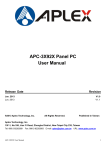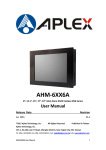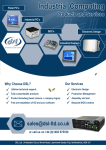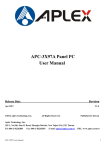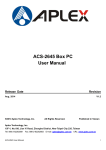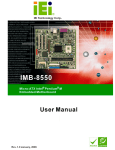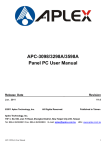Download Aplex APC-3x83 User manual
Transcript
APC-3x82/83 User Manual Release Date Revision Jan 2013 ® 2013 Aplex Technology, Inc. V1.0 All Rights Reserved. Published in Taiwan Aplex Technology, Inc. 15F-1, No.186, Jian Yi Road, Zhonghe District, New Taipei City 235, Taiwan Tel: 886-2-82262881 Fax: 886-2-82262883 E-mail: [email protected] APC-3x82/83 User Manual URL: www.aplex.com.tw 1 Warning!_______________________________ This equipment generates, uses and can radiate radio frequency energy and if not installed and used in accordance with the instructions manual, it may cause interference to radio communications. It has been tested and found to comply with the limits for a Class A computing device pursuant to FCC Rules, which are designed to provide reasonable protection against such interference when operated in a commercial environment. Operation of this equipment in a residential area is likely to cause interference in which case the user at his own expense will be required to take whatever measures may be required to correct the interference. Electric Shock Hazard – Do not operate the machine with its back cover removed. There are dangerous high voltages inside. Disclaimer This information in this document is subject to change without notice. In no event shall Aplex Technology Inc. be liable for damages of any kind, whether incidental or consequential, arising from either the use or misuse of information in this document or in any related materials. APC-3x82/83 User Manual 2 Packing List Accessories (as ticked) included in this package are: □ AC power cable □ Driver & manual CD disc □ Other.___________________(please specify) Safety Precautions Follow the messages below to avoid your systems from damage: ◆ Avoid your system from static electricity on all occasions. ◆ Prevent electric shock. Don„t touch any components of this card when the card is power-on. Always disconnect power when the system is not in use. ◆ Disconnect power when you change any hardware devices. For instance, when you connect a jumper or install any cards, a surge of power may damage the electronic components or the whole system. APC-3x82/83 User Manual 3 Table of Contents______________________ Warning!…………………………………………………………………………….……..….2 Disclaimer………………………………………………………………….…………………2 Packing List...................................................................................................................3 Safety Precautions........................................................................................................3 Chapter 1 Getting Started 1.1 Specifications………………………………………….………….……...…..6 1.2 Dimensions…………………………………...……………….…………......8 1.3 Brief Description of APC-3X82/3X83.………………….………………12 Chapter 2 Hardware Installation 2.1 Mainboard Specifications………………………..…………….…………13 2.2 Jumpers Setting and Connectors………………………….……………17 Chapter 3 BIOS Setup 3.1 Operations after POST Screen.............................................................26 3.2 BIOS SETUP UTILITY................................................................27 3.3 System Overview.......................................................................28 3.4 Advanced Settings................................................................... 29 3.5 Advanced PCI/PnP Settings................................................................ 37 3.6 Boot Settings....................................................................................... 40 3.7 Security Settings.................................................................................. 42 3.8 Advanced Chipset Settings.................................................................. 43 3.9 Exit Options..........................................................................................49 3.10 Examples of GPIO Programming.......................................................50 APC-3x82/83 User Manual 4 Chapter 4 Installation of Drivers 4.1 Intel Chipset Driver.…………………………...……………………………59 4.2 Intel GMA 3150 VGA Chipset Driver..…....…......……………….......…..62 4.3 Intel 82574L Network adapter Driver……..................................……….66 4.4 Realtek HD Audio Driver Installation………………….…………………69 Chapter 5 Touch Screen Installation 5.1 Introduction to Touch Screen Controller Board………………………....72 5.2 Windows 2000/XP USB Driver Installation………………….………..….72 Figures Figure 1.1: Dimensions of APC-3282/APC-3283……………………………...8 Figure 1.2: Dimensions of APC-3582/APC-3583.....……………………...9 Figure 1.3: Dimensions of APC-3782/APC-3783……...………………..10 Figure 1.4: Dimensions of APC-3982/APC-3983…………...………………..11 Figure 1.5: Overview of APC-3X82 ……..…………………………...12 Figure 1.6: Overview of APC-3X83.........................................12 Figure 2.1: Mainboard Overview……………………………………..……..…13 Figure 2.2: Mainboard Dimensions……………………………………………13 Figure 2.3: Jumpers and Connectors Location-TOP…………………...……14 Figure 2.4: Jumpers and Connectors Location- Bottom………………….…14 Figure 5.1: Bird‟s Eye View of Control Board…………………………….......72 APC-3x82/83 User Manual 5 Chapter 1________________Getting Started 1.1 Specifications Model No. Specs APC-3282/3283 APC-3582/3583 APC-3782/3783 APC-3982/3983 System Processor Intel Atom D525 1.8GHz processor FSB 800MHz System Chipset Intel ICH8M Chipset System Memory 1 x 204 Pin SO-DIMM DDR3 800GHz, up to 2GB SDRAM Storage 1 x 2 .5" SATA HDD Space 1 x CF Internal Slot 1 x CF External Slot for option (except APC-3282/3283) External I/O Port 4XUSB 2.0 2XGbE RJ-45 LAN port 1XDB-15 VGA (disable for use) 1XDB-9 RS422/485(default RS-485) 1XDB-9 RS-232 1XDC Power input T/B connector 7 Pin T/B for 2in/out/1Ground/Switch± Expansion Slots None OSD OSD control Brightness/ Screen and Touch on/off /Power on/off (APC-3782/3783/3982/3983 add auto tune function key) OS support Windows XP Pro, XP Embedded, Windows Embedded Standard 7 LCD Display Type 12.1”TFT-LCD 15”TFT-LCD 17”TFT-LCD 19”TFT-LCD 800x600 1024x768 1280x1024 1280x1024 Max. Resolution Max. Color 262K Luminance (cd/m2) 350 View Angle 400 350 350 H:170° / V:160° H:160° / V:160° H:160° / V:140° H:130° / V:110° (APC-3582) H:140° / V:110° (APC-3583) Backlight Lifetime 50,000 hrs Touch Screen Type Resistive Touch Light Transmission 80% Power Supply Power Input APC-3x82/83 User Manual DC 11~32V 6 Mechanical Construction Stainless Steel Housing (APC-3X82) / Steel Housing (APC-3X83) IP Rating Front Panel IP65 / 6 sides IP42 with waterproof kit Mounting VESA 75x75 VESA 75x75 VESA 75x75 VESA 100x100 Mount Mount Mount Mount 335(W)x265(H) 399(W)x324(H)x 432(W)x358(H)x 470(W)x388.6(H)x x67(D) mm 67(D) mm 66.8(D)mm 67(D)mm Dimensions (WxHxD) Environmental Operating Temperature 0~50 ゚ C Storage Temperature -20~60 ゚ C Storage Humidity 10~90% @40 ゚ C non-condensing Certificate CE/FCC Class A APC-3x82/83 User Manual 7 1.2 Dimensions Figure 1.1: Dimensions of APC3282/ APC-3283 APC-3x82/83 User Manual 8 Figure 1.2: Dimensions of APC-3582/APC-3583 APC-3x82/83 User Manual 9 Figure 1.3: Dimensions of APC-3782/APC-3783 APC-3x82/83 User Manual 10 Figure 1.4: Dimensions of APC-3982/APC-3983 APC-3x82/83 User Manual 11 1.3 Brief Description of APC-3X82/3X83 The fanless APC-3X82/3X83 is Intel Atom D525 powered panel PC with a rich variety of functions and peripherals. APC-3X82/3X83 is designed for easy and simplified integration into various vehicle applications. It comes with a compact flash slot, 2.5-inch hard disk drive, DDR3 memory, audio jack, 2 Ethernet, DC input. 4 external USB ports ensure simplified connectivity to a variety of external peripheral devices. The unit supports Windows XP Pro, XP Embedded and Windows Embedded Standard 7. The fanless touch panel computer is ideal for use as Web Browser, Terminal and HMI at all levels of automation control. Figure 1.5: Overview of APC-3X82 Figure 1.6: Overview of APC-3X83 APC-3x82/83 User Manual 12 Chapter 2__________Hardware Installation 2.1 Mainboard Specifications Figure 2.1: Mainboard Overview Figure 2.2: Mainboard Dimensions APC-3x82/83 User Manual 13 Figure 2.3: Jumpers and Connectors Location-TOP Figure 2.4: Jumpers and Connectors Location- Bottom APC-3x82/83 User Manual 14 Specifications Board Size 165mm x 115mm CPU Support Intel Atom D525 /1.80GHz (onboard) Intel Atom N455 /1.66GHz (onboard option) Chipset Intel Atom D525 + Intel ICH8M Intel Atom N455 + Intel ICH8M (option) Intel Atom N455 + Intel ICH8M-E (option, Support RAID0/1) Memory Support 1x SO-DIMM (204pins), up to 2GB DDR3 800MHz FSB Graphics Integrated by D525 / N455 GMA 3150 Super I/O Winbond W83627UHG BIOS AMIBIOS Storage 3 x SATA Connector 1 x Compact Flash II Slot (shared IDE) Network 2 x RJ-45 1000Mbps LAN Intel 82574L USB 4 x USB 2.0 stack port for external 2 x USB 2.0 internal Pin header 2 x USB 2.0 internal for mini PCIe 1 x RS232 port, DB9 connector for external (COM1), Serial pin 9 w/5V/12V/Ring select 1 x RS232/422/485 select header for internal (COM3), default RS232 4 x RS232 (COM2,COM4,COM5,COM6), header internal Digital I/O 8-bit digital I/O by Pin header 4-bit digital Input 4-bit digital Output Battery Support CR2477 Li battery by 2-pin header Audio Support Audio via Realtek ALC662 HD audio decoder Support Line-in, Line-out, MIC by 2x5-pin header Keyboard /Mouse Expansion Bus Power Management APC-3x82/83 User Manual 1x PS2 keyboard/mouse by 1x6 box pin header 1x PC 104+ connector (PCI master 4, jumper for +3.3V & 5V select) 2x mini-PCI-express slot (1x full size, 1x half-size ) DC12V input 1 x 2-pin power input connector 15 by 2x5-pin header Front I/O Power on/off switch Reset switch Power LED status HDD LED status Buzzer Software programmable 1 – 255 second by Super I/O Watchdog Timer External port I/O 1 x COM Port (COM1) 4 x USB 2.0 Ports (stack) 2 x RJ45 GbE Ports (10/100/1000Mbps) 1 x DB15 Port or 2x8 Pin Header Temperature Operating: -20℃–70℃ Storage: -40℃–85℃ Humidity 5% - 95%, non-condensing, operating Power Consumption 12V /1.6A (Intel D525 processor with 2GB DDR3 DRAM) 12V /1.3A (Intel N455 processor with 2GB DDR3 DRAM) EMI/EMS Meet CE/FCC class A APC-3x82/83 User Manual 16 2.2 Jumpers Setting and Connectors 1. JCLR_CMOS: (2.0mm Pitch 1x3 Pin Header)CMOS clear jumper, CMOS clear operation will permanently reset old BIOS settings to factory defaults. JCLR_CMOS CMOS CLOSE 1-2 NORMAL (default) CLOSE 2-3 Clear CMOS Procedures of CMOS clear: 5.4.1.1 Turn off the system and unplug the power cord from the power outlet. 5.4.1.2 To clear the CMOS settings, use the jumper cap to close pins 2 and 3 for about 3 seconds then reinstall the jumper clip back to pins 1 and 2. 5.4.1.3 Power on the system again. 5.4.1.4 When entering the POST screen, press the <F1> or <DEL> key to enter CMOS Setup Utility to load optimal defaults. 5.4.1.5 After the above operations, save changes and exit BIOS Setup. 2. JVCCIO: (2.0mm Pitch 1x3 Pin Header) PC104+ port voltage selection jumper,select voltage for PCI-104 Plus device. The default for this jumper is “all open”,meaning the user must select the voltage to be used. JVCCIO PC104+ Voltage VCCIO CLOSE 1-2 +3.3V CLOSE 2-3 +5V all Open (Default) 3. BZ: onboard buzzer. 4. JCOM6: (2.0mm Pitch 1x3 Pin Header) COM6 setting jumper, pin 1~3 are used to select signal out of pin 10 of COM6 port. JP1 Pin# Function Close 1-2 COM6 Pin10=+5V (default) Close 2-3 COM6 Pin10=+12V (option) 5. JP2: (2.0mm Pitch 1X2 Pin Header), ATX Power and Power auto on setting jumper. JP2 APC-3x82/83 User Manual Mode 17 Open ATX Power Mode Close Power Auto on (Default) 6. BAT: (1.25mm Pitch 1x2 box Pin Header) 3.0V Li battery is embedded to provide power for CMOS. Pin# Signal Name Pin1 VBAT PIN2 Ground 7. F_PANEL: (2.0mm Pitch 2X5 Pin Header), Front panel connector. Signal Name Pin# Pin# Signal Name HD LED+ 1 2 POWER LED+ HD LED- 3 4 POWER LED- Ground 5 6 PWRBTN RESET 7 8 Ground BUZZER+ 9 10 BUZZER- Pin1-3: HDD LED, They are used to connect hard disk activity LED. The LED blinks when the hard disk is reading or writing data. Pin2-4: POWER LED, They are used to connect power LED. When the system is powered on or under S0/S1 state, the LED is normally on; when the system is under S4/S5 state, the LED is off. Pin5-6: POWER on/off Button, They are used to connect power switch button. The two pins are disconnected under normal condition. You may short them temporarily to realize system startup & shutdown or awaken the system from sleep state. Pin7-8: RESET Button, They are used to connect reset button. The two pins are disconnected under normal condition. You may short them temporarily to realize system reset. Pin9-10: BUZZER, They are used to connect an external buzzer. Note: When connecting LEDs and buzzer, pay special attention to the signal polarity. Make sure that the connector pins have a one-to-one correspondence with chassis wiring, or it may cause boot up failure. APC-3x82/83 User Manual 18 8. USB3: (2.0mm Pitch 2x5 Pin Header) ,Front USB connector, it provides two USB ports via a dedicated USB cable, speed up to 480Mb/s. Signal Name Pin# Pin# Signal Name +5V 1 2 +5V USB_P6_DN 3 4 USB_P7_DN USB_P6_DP 5 6 USB_P7_DP Ground 7 8 Ground NC 9 10 Ground Note: Before connection, make sure that pinout of the USB Cable is in accordance with that of the said tables. Any inconformity may cause system down and even hardware damages. 9. JCOM: (2.0mm Pitch 2x6 Pin Header) COM1 and COM3 setting jumper, pin 1~6 are used to select signal out of pin 9 of COM1 port; pin 7~12 are used to select output type for COM3 port (RS232 Type or RS422 Type or RS485 Type). JCOM Pin# CLOSE 1-2 Function COM1 Pin9=RI (default) CLOSE 3-4 COM1 Pin9=+5V CLOSE 5-6 COM1 Pin9=+12V (option) CLOSE 7-9 COM3 CLOSE 8-10 COM3 FOR RS485 FROM COM33 (option) (option) FOR RS232 (default) FROM COM3 CLOSE 10-12 COM3 FOR RS422 FROM COM33 (option) Note: Since COM3 and COM33 use the same address, they cannot work at the same time. 10. GPIO: (2.0mm Pitch 2x5 Pin Header),General-purpose input/output port, it provides a group of self-programming interfaces to customers for flexible use. Signal Name GPIO20 APC-3x82/83 User Manual Pin# Pin# 1 2 Signal Name GPIO60 19 GPIO21 3 4 GPIO61 GPIO22 5 6 GPIO62 GPIO23 7 8 GPIO63 Ground 9 10 +5V 11. COM3: (2.0mm Pitch 1x4 box Pin Header),it provides selectable RS422/RS485 serial signal output. RS422 Type (option) RS485 Type (option) Signal Name Pin# Pin# Signal Name 422RXD- 1 1 NC 422RXD+ 2 2 NC 422TXD- 3 3 485A- 422TXD+ 4 4 485A+ Note: Use COM3 RS232/RS485 Function, please setting JCOM Jumpers and BIOS CMOS Setup. Path: BIOS Setup Utility \ Advanced Setting \ SuperIO Configuration \ Serial Port3 Type: [RS232 Type] [RS485 Type] 12. F_AUDIO: (2.0mm Pitch 2x5 Pin Header), Front Audio, An onboard Realtek ALC662 codec is used to provide high-quality audio I/O ports. Line Out can be connected to a headphone or amplifier. Line In is used for the connection of external audio source via a Line in cable. MIC is the port for microphone input audio. Signal Name Pin# Pin# Signal Name FRONT-OUT-L 1 2 LINEIN_R AUD_AGND 3 4 AUD_AGND FRONT-OUT-R 5 6 LINEIN_L AUD_AGND 7 8 AUD_AGND FRONT-MIC_L 9 10 FRONT-MIC_ R 13. COM2-COM6: (2.0mm Pitch 2x5 Pin Header),COM2 COM3 COM4 COM5 COM6 Ports, up to 5 standard RS232 ports are provided. They can be used directly via COM cable connection. APC-3x82/83 User Manual 20 COM2,COM3,COM4,COM5 Signal Name: Signal Name Pin# Pin# Signal Name DCD 1 2 RXD TXD 3 4 DTR Ground 5 6 DSR RTS 7 8 CTS RI 9 10 NC COM6 Signal Name: Signal Name Pin# Pin# Signal Name DCD 1 2 RXD TXD 3 4 DTR Ground 5 6 DSR RTS 7 8 CTS RI 9 10 JCOM6 Setting: Pin1-2 : 5V (Default) Pin2-3:12V (option) Note: COM3 port is controlled by pins No.7~10 of JCOM. For details, please refer to description of JCOM and COM33 BIOS Setup. 14. KB/MS: (2.0mm Pitch 1x6 box Pin Header), PS/2 keyboard and mouse port, the port can be connected to PS/2 keyboard or mouse via a dedicated cable for direct used. Pin# Signal Name 1 KBDATA 2 MSDATA 3 Ground 4 +5V 5 KBCLK 6 MSCLK 15. USB1/2: (Double stack USB type A), Rear USB connector, it provides up to 4 APC-3x82/83 User Manual 21 USB2.0 ports, speed up to 480Mb/s. Each USB Type A Receptacle (2 Ports) Current limited value is 1.5A. If the external USB device current exceeds 1.5A, please separate connectors into different Receptacle. 16. LAN1/2: (RJ45 Connector), Rear LAN port,2 standard 10/100/1000M RJ-45 Ethernet ports are provided. Used Intel 82567LM chipset ,LINK LED (green) and ACTIVE LED (yellow) respectively located at the left-hand and right-hand side of the Ethernet port indicate the activity and transmission state of LAN. 17. VGA: (CRT Connector DB15),Video Graphic Array Port, provide high-quality video output. They can not work at the same time for VGA and VGA-PH. 18. VGA-PH: (CRT 2.0mm Pitch 2x8 Pin Header), Video Graphic Array Port, Provide 2x8 Pin cable to VGA Port, they can not work at the same time for VGA and VGA-PH. Signal Name APC-3x82/83 User Manual Pin# Pin# Signal Name CRT_RED 1 2 Ground CRT_GREEN 3 4 Ground CRT_BLUE 5 6 NC CRT_R_HSYN C 7 8 CRT_PU_DDC_DAT CRT_R_VSYN C 9 10 CRT_PU_DDC_CLK NC 11 12 NC +12V 13 14 Ground +12V 15 16 Ground 22 19. CPU SCREW HOLES: Four screw holes for fixed CPU Cooler assemble. 20. COM1: (Type DB9),Rear serial port, standard DB9 serial port is provided to make a direct connection to serial devices. COM1 port is controlled by pins No.1~6 of JCOM, select output Signal RI or 5V or 12v, For details, please refer to description of JCOM. 21. AT12V: (5.0mm 1x2 Pin Connector),DC12V System power input connector。 Pin# Signal Name 1 +12V 2 Ground Note: Make sure that the voltage of power supply is DC(12±5%)V before power on, or it may cause boot up failure and even system damage. 22. FAN: (2.54mm Pitch 1x3 Pin Header), Fan connector, cooling fans can be connected directly for use. You may set the rotation condition of cooling fan in menu of BIOS CMOS Setup. Pin# Signal Name 1 Ground 2 VCC 3 Rotation detection Note: Output power of cooling fan must be limited under 5W. 23. LVDS: For 18 bit LVDS output connector, Fully supported by Intel Atom D525 chipset, the interface features single channel 18-bit output. Model name of the interface connector is Hirose DF13-30DP-1.25V. APC-3x82/83 User Manual Signal Name Pin# Pin# Signal Name LVDS1_VDD5 1 2 LVDS1_VDD5 Ground 3 4 Ground 23 LVDS1_VDD3 3 5 6 LVDS1_VDD3 3 LADATAN0 7 8 NC LADATAP0 9 10 NC LADATAN1 11 12 NC LADATAP1 13 14 NC LADATAN2 15 16 NC LADATAP2 17 18 NC LACLKN 19 20 NC LACLKP 21 22 NC LDDC_CLK 23 24 NC LBKLT_EN 25 26 BKLT_CTRL Ground 27 28 Ground +V12S 29 30 +V12S 24. BKL: (2.0mm Pitch 1x5 box Pin Header), Backlight control connector for LVDS1. Pin# Signal Name 1 +DC12V 2 +DC12V 3 Ground 4 Ground 5 BKLT_EN 6 BKLT_CTRL 25. SATA1/2/3: (SATA 7P),SATA1,SATA2,SATA3 SATA Connectors. Three SATA connectors are provided, with transfer speed up to 3.0Gb/s. ASB-L706NE: SATA1/SATA2/SATA3 drives supporting RAID 0 or RAID 1 function 26. SATA_P2: (2.5mm Pitch 1x4 box Pin Header), onboard 5V and 12V output connector is reserved to provide power for SATA devices. Pin# Signal Name 1 +DC5V 2 Ground 3 Ground 4 +DC12V Note: Output current of the connector must not be above 1A. APC-3x82/83 User Manual 24 27. CN1: (2.5mm Pitch 1x2 box Pin Header), an onboard 5V output connector is reserved to provide power for IDE/SATA devices. Pin# Signal Name 1 +DC5V 2 Ground Note: Output current of the connector must not be above 1A. 28. PC104+: (4x30 Pin), PC104 plus connector, it conforms to standard PC104+ specification. 29. MPCIE2: (30mmx30mm Socket 52Pin), mini PCIE socket, it is located at the top, it supports mini PCI-E devices with USB2.0, SMBUS and PCI-E signal. 30. MPCIE2 SCREW HOLES: one screw holes for fixed MPCIE2 assemble. 31. MPCIE: (50.95x30mm socket 52Pin), mini PCIE socket, it is located at the bottom, it supports mini PCI-E devices with USB2.0, SMBUS and PCI-E signal. 32. CF: CF Card socket, it is located at the bottom of the board and serves as an insert interface for Type I and Type II Compact Flash card. The operating voltage of CF card can be set as 3.3V or 5V. The default setting of the product is 5V. 33. DDR3: (SO-DIMM 204Pin socket), DDRIII memory socket, the socket is located at the bottom of the board and supports 204Pin 1.5V DDRIII 800MHz FSB SO-DIMM memory module up to 2G. 34. MPCIE SCREW HOLES: one screw holes for fixed MPCIE assemble. APC-3x82/83 User Manual 25 Chapter 3 BIOS Setup 3.1 Operations after POST Screen After CMOS discharge or BIOS flashing operation, the system will display the following screen for your further operation. Press F2 key to continue or F1 key to enter CMOS Setup. AMIBIOS© 2009 American Mega trends , Inc. BIOS Date: 03/22/12 15:57:19 Ver: 08.00.16 CPU : Intel® Atom™ CPU D525 @ 1.80GHz Speed : 1.80 GHz Press F11 for BBS POPUP Initializing USB Controllers. . 2038MB OK Done. Auto-Detecting Pri Master.. IDE Hard Disk Pri Master : Hitachi HTS545016B9A300 PB0C64G Ultra DMA – 5, S.M.A.R.T. Capable and Status OK Auto – detecting USB Mass Storage Devices .. 00 USB Mass storage devices found and configured CMOS Settings Wrong CMOS Data / Time Not Set Press F1 to Run SETUP Press F2 to load default values and continue 0085 After optimizing and exiting CMOS Setup, the POST screen displayed for the first time is as follows and includes basic information on BIOS, CPU, memory, and storage devices. AMIBIOS© 2009 American Mega trends , Inc. BIOS Date: 03/22/12 15:57:19 Ver: 08.00.16 CPU : Intel® Atom™ CPU D525 @ 1.80GHz Speed : 1.80 GHz Press DEL to Run Setup Press F11 for BBS POPUP Initializing USB Controllers. . 2038MB OK Done. Auto-Detecting Pri Master.. IDE Hard Disk Pri Master : Hitachi HTS545016B9A300 PB0C64G Ultra DMA – 5, S.M.A.R.T. Capable and Status OK Auto – detecting USB Mass Storage Devices .. 00 USB Mass storage devices found and configured. Checking NVRAM.. 0085 Press F11 to load default values and continue 0085 Press F11 key to enter Boot Menu during POST, as shown by the following figure. APC-3x82/83 User Manual 26 Please select boot device: Hitachi HTS545016B9A300 USB: USB Hotplug FDD ↑and ↓ to move selection ENTER to select Boot device ESC to boot using defaults 3.2 BIOS SETUP UTILITY Press [Del] key to enter BIOS Setup utility during POST, and then a main menu containing system summary information will appear. BIOS SETUP UTILITY Main Advanced PCIPnP Boot Security Chipset Exit System Overview User [ENTER],[TAB] AMIBIOS or Version [SHIFT-TAB] to Select a field : 08.00.16 Build Date : 03/22/12 ID Use[+] or [-] to : L706V012 configure system Time. Processor Intel ® Atom™ CPU D525 Speed Count @ 1.80GHz :1800MHz :2 System Memory Size :2038MB System Time APC-3x82/83 User Manual [00:00:10] ← Select Screen ↑↓ Select Item +- Charge Field Tab Select Field F1 General Help F10 Save and Exit 27 System Date 01/01/2002] [Tue ESC Exit V02.68 © Copyright 1985-2009 American Mega trends , Inc. 3.3 System Overview BIOS SETUP UTILITY Main Advanced PCIPnP Boot Security Chipset Exit System Overview User [ENTER],[TAB] AMIBIOS or Version [SHIFT-TAB] to Select a field : 08.00.16 Build Date : 03/22/12 ID Use[+] or [-] to : L706V012 configure system Time. Processor Intel ® Atom™ CPU D525 Speed Count @ 1.80GHz :1800MHz :2 System Memory Size :2038MB System Time [00:06:31] System Date 01/01/2002] [Tue ← Select Screen ↑↓ Select Item +- Charge Field Tab Select Field F1 General Help F10 Save and Exit ESC Exit V02.68 © Copyright 1985-2009 American Mega trends , Inc. System Time: Set the system time, the time format is: Hour : Minute : 0 to 59 Second : 0 to 59 0 to 23 System Date: Set the system date, the date format is: Day: Month: Date: Year: APC-3x82/83 User Manual Note that the „Day‟ automatically changes when you set the date. 01 to 12 01 to 31 2010 to 2099 28 3.4 Advanced Settings BIOS SETUP UTILITY Main Advanced PCIPnP Boot Security Chipset Advanced Settings Exit Configure CPU WARNING: Setting wrong values In below sections may cause system to malfunction. ► CPU Configuration ► IDE Configuration ► Super IO Configuration ► Hardware Health Configuration ► ACPI Configuration ← Select Screen ► AHCI Configuration ↑↓ Select Item ► ASF Configuration Enter Charge Field ► MPS Configuration F1 General Help ► PCI Express Configuration F10 Save and Exit ► Smbios Configuration ESC Exit ► USB Configuration V02.68 © Copyright 1985-2009 American Mega trends , Inc. 3.4.1 CPU Configuration BIOS SETUP UTILITY Main Advanced PCIPnP Boot Security Chipset Advanced Settings Exit Configure CPU WARNING: Setting wrong values In below sections may cause system to malfunction. ► CPU Configuration ► IDE Configuration ► Super IO Configuration ► Hardware Health Configuration ► ACPI Configuration ← Select Screen ► AHCI Configuration ↑↓ Select Item ► ASF Configuration Enter Charge Field ► MPS Configuration F1 General Help ► PCI Express Configuration F10 Save and Exit APC-3x82/83 User Manual 29 ► Smbios Configuration ESC Exit ► USB Configuration V02.68 © Copyright 1985-2009 American Mega trends , Inc. 3.4.2 IDE Configuration BIOS SETUP UTILITY Advanced IDE Configuration ATA/IDE Configuration Configure SATA as Options [Enhanced] [IDE] ► Primary IDE Master Detected] : [Not ► Primary IDE Slaver Detected] : [Not ► Secondary IDE Master Detected] : [Not ► Secondary IDE Slaver Detected] : [Not ► Third IDE Master : [Not Detected] ► Third IDE Slaver Detected] : [Not ► Fourth IDE Master Detected] : [Not ► Fourth IDE Slaver Detected] : [Not Enhanced ← Select Screen ↑↓ Select Item +- Charge Field F1 General Help F10 ESC Hard Disk Write Protect [Disabled] IDE Detect Time Out (Sec) [35] ATA(PI) 80Pin Cable Detection Device] Disabled Save and Exit Exit [Host & V02.68 © Copyright 1985-2009 American Mega trends , Inc. ATA/IDE Configuration: [Enhanced] [Disabled] Configure SATA as: APC-3x82/83 User Manual 30 [IDE] [RAID] [AHCI] Hard Disk Write Protect: [Disabled] [Enabled] IDE Detect Time Out : [35] Options: [0,5,10,15,20,25,30,35] ATA(PI) 80Pin Cable Detection: [Host & Device] [Host] [Device] 3.4.3 Super IO Configuration BIOS SETUP UTILITY Advanced Configure Win627UHG Super IO Chipset Allow BIOS to Select Serial Port1 Address Serial Port Base [3F8] Serial Port1 IRQ [IRQ4] Serial Port2 Address [2F8] Serial Port2 IRQ [IRQ3] Serial Port3 Address [3E8] Serial Port3 IRQ [IRQ5] Serial Port3 Type Type] Address. [RS232 Serial Port4 Address [2E8] Serial Port4 IRQ [IRQ6] Serial Port5 Address [2F0] Serial Port5 IRQ [IRQ10] Serial Port6 Address [2E0] Serial Port6 IRQ [IRQ11] WatchDog Setting [Disable] ← Select Screen ↑↓ Select Item +- Charge Field F1 General Help F10 ESC Save and Exit Exit V02.68 © Copyright 1985-2009 American Mega trends , Inc. Serial Port3 Type: COM3 Options: [RS232 Type] APC-3x82/83 User Manual 31 [RS485 Type] WatchDog Setting: [Disable] Options: [10sec,20sec,30sec,40sec,1min,2min,4min] 3.4.4 Hardware Health Configuration BIOS SETUP UTILITY Advanced Hardware Health Configuration CPU Temperature :41℃/105℉ CPUFAN Speed setting :4800 RPM CPUFAN Mode Setting Mode ] CPUFAN PWM Control Fan configuration mode [Manual [250 ] ← Select Screen ↑↓ Select Item +- Charge Field F1 General Help F10 ESC Save and Exit Exit V02.68 © Copyright 1985-2009 American Mega trends , Inc. CPU Temperature: Show you the current CPU temperature. CPUFAN Speed: Show you the current CPU Fan operating speed. CPUFAN Mode Setting: [Manual Mode] [Thermal Cruise Mode] [Speed Cruise Mode] [Smart Fan3 Mode] 3.4.5 ACPI Configuration Section for Advanced ACPI Configuration Options: [Advanced ACPI Configuration] [Chipset ACPI Configuration] 3.4.6 AHCI Configuration APC-3x82/83 User Manual 32 BIOS SETUP UTILITY Advanced AHCI Configuration While entering setup, ► AHCI Port0 Detected] : [Not ► AHCI Port1 Detected] : [Not ► AHCI Port2 Detected] : [Not BIOS auto detects the presence of IDE devices. This displays the status of auto detecting of IDE devices ← Select Screen ↑↓ Select Item Enter Go to sub screen F1 General Help F10 Save and Exit ESC Exit V02.68 © Copyright 1985-2009 American Mega trends , Inc. While entering setup, BIOS auto detects the presence of IDE devices. This displays the status of auto detecting of IDE devices 3.4.7 MPS Configuration BIOS SETUP UTILITY Advanced MPS Configuration MPS Revision Select [1.4] Revision ← Select Screen ↑↓ Select Item +- Charge Field F1 General Help F10 ESC Save and Exit Exit V02.68 © Copyright 1985-2009 American Mega trends , Inc. Configure the Multi-Processor Table. MPS Revision: [1.4] APC-3x82/83 User Manual 33 [1.1] 3.4.8 PCI Express Configuration BIOS SETUP UTILITY Advanced PCI Express Configuration Enables/Disables Relaxed Ordering [Auto] PCI Express Device Maximum Payload Size [Auto] Relaxed Ordering Extended Tag Field [Auto] No Snoop [Auto] Maximum Read Request Size [Auto] Active State Power Management Extended Synch [Disabled] [Auto] ← Select Screen ↑↓ Select Item +- Charge Field F1 General Help F10 Save and Exit ESC Exit V02.68 © Copyright 1985-2009 American Mega trends , Inc. Relaxed Ordering: [Auto] [Disabled] [Enable] Maximum Payload Size: [Auto] [128/256/512/1024/2048/4096 Bytes] Set Maximum Payload of allow System BIOS select the value. Extended Tag Field: [Auto] [Disabled] [Enable] No Snoop: [Auto] [Disabled] [Enable] Maximum Read Request Size: [Auto] [128/256/512/1024/2048/4096 Bytes] Set Maximum Read Request Size of PCI Express Device or allow System BIOS select the value. APC-3x82/83 User Manual 34 Active State Power Management: [Disabled] [Enable] Extended Synch: [Auto] [Disabled] [Enable] 3.4.9 Smbios Configuration BIOS SETUP UTILITY Advanced Smbios Configuration Smbios Smi Support SMBIOS SMI Wrapper [Enabled] Support for PnP Func 50h-54h ← Select Screen ↑↓ Select Item +- Charge Field F1 General Help F10 Save and Exit ESC Exit V02.68 © Copyright 1985-2009 American Mega trends , Inc. Smbios Smi Support: [Enable] [Disabled] 3.4.10 USB Configuration BIOS SETUP UTILITY Advanced APC-3x82/83 User Manual 35 USB Configuration Enables support for Module Version – 2.24.5-14.4 legacy USB.ATUO option disables legacy support if no USB USB Devices Enabled : None devices are connected Legacy USB Support USB2.0 Controller Mode BIOS EHCI Hand-Off Hotplug USB FDD Support [Enabled] [Hispeed] [Enabled] [Auto] ► USB Mass Storage Device Configuration ← Select Screen ↑↓ Select Item +- Charge Field F1 General Help F10 Save and Exit ESC Exit V02.68 © Copyright 1985-2009 American Mega trends , Inc. Legacy USB Support: [Enable] [Disabled] USB2.0 Controller Mode: [HiSpeed] [FullSpeed] BIOS EHCI Hand-Off: [Enable] [Disabled] Hotplug USB FDD Support: [Auto] [Disabled] [Enable] USB Mass Storage Device Configuration: BIOS SETUP UTILITY APC-3x82/83 User Manual 36 Advanced USB Mass Storage Device Configuration Number of seconds USB Mass Storage Reset Delay POST waits for the USB [20 Sec] mass storage device Device #1 after start unit command USB Hotplug Emulation Type [Auto] ← Select Screen ↑↓ Select Item +- Charge Field F1 General Help F10 Save and Exit ESC Exit V02.68 © Copyright 1985-2009 American Mega trends , Inc. 3.5 Advanced PCI/PnP Settings This part describes configurations to be made on PCI bus system. PCI, namely Personal Computer Interconnect, is a computer bus that allows I/O device to operate nearly as fast as CPU in its own way. Some technical terms will be mentioned here. We recommend that non-professional users not make changes from factory default settings. BIOS SETUP UTILITY Main Advanced PCIPNP Boot Security Chipset Advanced PCI/PnP Settings Clear NURAM during WARNING: Setting wrong values In below sections may cause system to malfunction. Clear NVRAM [No] PCI Latency Timer [64] Allocate IRQ to PCI VGA [Yes] Palette Snooping [Disabled] PCI IDE BusMaster [Enabled] OffBoard PCI/ISA IDE Card [Auto] APC-3x82/83 User Manual System Boot [No] Plug & Play O/S IRQ3 [Available] Exit ← Select Screen ↑↓ Select Item +- Charge Field F1 General Help 37 IRQ4 [Available] F10 ESC Save and Exit Exit IRQ5 [Available] IRQ6 [Available] IRQ7 [Available] IRQ9 [Available] IRQ10 [Available] V02.68 © Copyright 1985-2009 American Mega trends , Inc. Clear NVRAM: [No] [Yes] Plug & Play OS: [No] [Yes] PCI Latency Timer: [64] [32] [96] [128] [160] [192] [224] [248] Allocate IRQ to PCI/VGA: [Yes] [No] Palette Snooping: [Disabled] [Enable] PCI IDE BusMaster: [Disabled] APC-3x82/83 User Manual 38 [Enable] OffBoard PCI/ISA IDE Card: Some PCI IDE cards may require this to be set to the PCI slot number that is holding the card. Auto:Works for most PCI IDE Cards. [Auto] [PCI Slot1] [PCI Slot2] [PCI Slot3] [PCI Slot4] [PCI Slot5] [PCI Slot6] IRQ3/4/5/7/9/10/11/14/15: [Available] [Reserved] Available: Specified IRQ is available to be used by PCI/PnP devices. Reserved: Specified IRQ is reserved for use by legacy ISA devices. DMA Channel 0/1/3/5/6/7: [Available] [Reserved] Available: Specified DMA is available to be used by PCI/PnP devices. Reserved: Specified DMA is reserved for use by legacy ISA devices. Reserved Memory Size: Size of memory block to reserve for legacy ISA devices. [Disabled] [16k] [32k] [64k] APC-3x82/83 User Manual 39 3.6 Boot Settings BIOS SETUP UTILITY Main Advanced PCIPnP Boot Security Chipset Exit Boot Settings Configure Settings ► Boot Setting Configuration During System Boot ► Boot Device Priority ← Select Screen ↑↓ Select Item +- Charge Field F1 General Help F10 ESC Save and Exit Exit V02.68 © Copyright 1985-2009 American Mega trends , Inc. Boot Setting Configuration: Quick Boot: [Enabled] [Disabled] Allows BIOS to skip certain tests while booting .This will decrease the time needed to boot the system. Quiet Boot: [Disabled] [Enabled] Disabled: Displays normal POST messages. Enabled: Displays OEM logo instead of POST messages. AddOn ROM Display Mode: Set display mode for Option ROM. APC-3x82/83 User Manual 40 [Force BIOS] [Keep Current] Bootup Num-Lock: Select Power-on state for Numlock. [On] [Off] PS/2 Mouse Support,: Select support for PS/2 Mouse. [Auto] [Enabled] [Disabled] Wait For „F1‟ If Error: Wait for F1 key to be pressed if error occurs. [Enabled] [Disabled] Hit „DEL‟Messgae Display : Displays “press” DEL to run Setup in POST. [Enabled] [Disabled] Interrupt 19 Capture: [Disabled] [Enabled] Enabled: Allows option ROMs to trap interrupt 19. Boot Device Priority: Specifies the Boot Device Priority sequence. APC-3x82/83 User Manual 41 3.7 Security Settings BIOS SETUP UTILITY Main Advanced PCIPnP Boot Security Chipset Security Settings Supervisor Password User Password Exit Install or Change the :Not Installed :Not Installed password. Change Supervisor Password Change User Password Boot Sector Virus Protection [Disabled] ← Select Screen ↑↓ Select Item Enter Charge F1 General Help F10 Save and Exit ESC Exit V02.68 © Copyright 1985-2009 American Mega trends , Inc. Change Supervisor Password: Install or Change the password. Change User Password: Install or Change the password. Password Check: [Setup] [Always] Setup: Check password while invoking setup. Always: Check password while invoking setup a well as on each boot. Boot Sector Virus Protection: [Disabled] [Enabled] Enabled / Disabled Boot Sector Virus Protection. Type the password with up to 6 characters and then press Enter key. This will clear all previously typed CMOS passwords. You will be requested to confirm the APC-3x82/83 User Manual 42 password. Type the password again and press Enter key. You may press Esc key to abandon password entry operation. To clear the password, just press Enter key when password input window pops up. A confirmation message will be shown on the screen as to whether the password will be disabled. You will have direct access to BIOS setup without typing any password after system reboot once the password is disabled. Once the password feature is used, you will be requested to type the password each time you enter BIOS setup. This will prevent unauthorized persons from changing your system configurations. Also, the feature is capable of requesting users to enter the password prior to system boot to control unauthorized access to your computer. Users may enable the feature in Security Option of Advanced BIOS Features. If Security Option is set to System, you will be requested to enter the password before system boot and when entering BIOS setup; if Security Option is set to Setup, you will be requested for password for entering BIOS setup. 3.8 Advanced Chipset Settings BIOS SETUP UTILITY Main Advanced PCIPnP Boot Security Chipset Advanced Chipset Settings WARNING: Setting wrong values in below sections may cause system to malfunction Exit Configure North Bridge feature ► North Bridge Configuration ► South Bridge Configuration ← Select Screen ↑↓ Select Item Enter Go to sub screen F1 General Help F10 Save and Exit ESC Exit V02.68 © Copyright 1985-2009 American Mega trends , Inc. Note: Due to limited address length of BIOS, only a portion of panel parameters are listed in APC-3x82/83 User Manual 43 BIOS Setup. If the connected panel is not included in the parameter list, display problem will occur. In this case, Please do not change BIOS setup. 3.8.1 North Bridge Configuration BIOS SETUP UTILITY Chipset North Bridge Chipset Configuration Options PCI MMIO Allocation: 4Gb To 3072MB Auto DRAM Frequency [Auto] Max MHz Configure DRAM Timing by SPD [Enabled] Initate Graphic Adapter Internal [Enable,8MB] Graphics [IGD] Mode Select PEG Port Configuration ← Select Screen ↑↓ Select Item +- Charge Field F1 General Help F10 Save and Exit ESC ► Video Function Configuration Exit V02.68 © Copyright 1985-2009 American Mega trends , Inc. DRAM Frequency: [Auto] [Max MHz] Configure DRAM Timing By SPD: [Enabled] [Disabled] Initate Graphic Adapter: Select which graphics controller to use as the primary boot device. [IGD] [PCI/IGD] [PCI/PEG] [PEG/IGD] APC-3x82/83 User Manual 44 [PCIE/PCI] Internal Graphics Mode Select: [Enabled, 8MB] Video Function Configuration: BIOS SETUP UTILITY Chipset Video Function Configuration Options DVMT Mode Select Mode] [DVMT DVMT/FIXED [256MB] Memory Boot DVMT Mode Display Device [VBIOS-Default] Flat [1024x768LVDS] Panel Panel Backlight Control HDCP Disabled] Fixed Mode Type [Level 9] Support ← Select Screen ↑↓ Select Item +- Charge option F1 General Help F10 ESC Save and Exit Exit V02.68 © Copyright 1985-2009 American Mega trends , Inc. DVMT Mode Select: [DVMT Mode] [FIXED Mode] APC-3x82/83 User Manual 45 DVMT/FIXED Memory Size: [256MB] [128MB] [Maximum DVMT] Boot Display Device: [VBIOS-Default] [CRT] [LVDS] [CRT + LVDS] Flat Panel Type: [1024x 768LVDS] [640x480LVDS] [800x600LVDS] [1280x1024LVDS] [1366x768LVDS] Panel Backlight Control: [Level9] [Level0~15] Note: Panel support PWM Function. 3.8.2 South Bridge Configuration: BIOS SETUP UTILITY Chipset North Bridge Chipset Configuration Options PCI MMIO Allocation: 4Gb To 3072MB Auto DRAM Frequency [Auto] Max MHz Configure DRAM Timing by SPD [Enabled] Initate Graphic Adapter Internal [Enable,8MB] Graphics PEG Port Configuration APC-3x82/83 User Manual [IGD] Mode Select ← Select Screen ↑↓ Select Item +- Charge Field F1 General Help 46 F10 ► Video Function Configuration ESC Save and Exit Exit V02.68 © Copyright 1985-2009 American Mega trends , Inc. DRAM Frequency: [Auto] [Max MHz] Configure DRAM Timing By SPD: [Enabled] [Disabled] Initate Graphic Adapter: Select which graphics controller to use as the primary boot device. [IGD] [PCI/IGD] [PCI/PEG] [PEG/IGD] [PCIE/PCI] Internal Graphics Mode Select: [Enabled, 8MB] Video Function Configuration: BIOS SETUP UTILITY Chipset Video Function Configuration DVMT Mode Select Mode] APC-3x82/83 User Manual Options [DVMT Fixed Mode DVMT Mode 47 DVMT/FIXED [256MB] Memory Boot [VBIOS-Default] Display Flat [1024x768LVDS] Panel Panel Backlight Control HDCP Disabled] Device Type [Level 9] Support ← Select Screen ↑↓ Select Item +- Charge option F1 General Help F10 ESC Save and Exit Exit V02.68 © Copyright 1985-2009 American Mega trends , Inc. DVMT Mode Select: [DVMT Mode] [FIXED Mode] DVMT/FIXED Memory Size: [256MB] [128MB] [Maximum DVMT] Boot Display Device: [VBIOS-Default] [CRT] [LVDS] [CRT + LVDS] Flat Panel Type: [1024x 768LVDS] [640x480LVDS] [800x600LVDS] [1280x1024LVDS] [1366x768LVDS] APC-3x82/83 User Manual 48 Panel Backlight Control: [Level9] [Level0~15] Note: Panel support PWM Function. 3.9 Exit Options BIOS SETUP UTILITY Main Advanced PCIPnP Boot Security Chipset Exit Exit Options Exit system setup Save Changes and Exit after saving the changes Discard Changes and Exit Discard Changes F10 key can be used For this operation Load Optimal Defaults Load Failsafe Defaults ← Select Screen ↑↓ Select Item Enter Go to sub screen F1 General Help F10 Save and Exit ESC Exit V02.68 © Copyright 1985-2009 American Mega trends , Inc. Save Changes and Exit: Save configuration changes and exit setup? (F10 key can be used for this operation) [OK] [Cancel] Discard Changes and Exit: Discard Changes and Exit setup? (ESC key can be used for this operation) [OK] APC-3x82/83 User Manual 49 [Cancel] Discard Changes: Diacard changes? (F7 key can be used for this operation) [OK] [Cancel] Load Optimized Defaults: Load Optimized Defaults? (F9 key can be used for this operation) [OK] [Cancel] Load Fail-Safe Defaults: Load Fail-Safe Defaults? (F9 key can be used for this operation) [OK] [Cancel] 3.10 Examples of GPIO Programming 3.10.1 SuperIO Model: Winbond W83627UHG GPIO OUT use GP 60~63 GPIO IN use GP 20~23 3.10.2 W83627UHG Access index port: 4Eh/4Fh Index Address Port: 4Eh Index Data Port: 4Fh 3.10.3 Configure GPIO register sequence 1. Enter the extended function mode 2. Select logic device number 8 3. Activate the logic device GPIO Port 6 4. Configure GPIO Port 6 register 5. Select logic device number 9 6. Activate the logic device GPIO Port 2 7. Configure GPIO Port 2 register 8. Exit the extended function mode APC-3x82/83 User Manual 50 3.10.4 Read/write GPIO sequence 1. Enter the extended function mode 2. Select logic device number 3. Read/write GPIO register value 4. Exit the extended function mode 3.10.5 Software programming example Enter the extended function mode Writing 87h to index address port twice will enter the extended function mode. Example x86 assembly code: mov dx, 4Eh mov al, 87h out dx, al out dx, al Example C code: outportb(0x4E, 0x87); outportb(0x4E, 0x87); Exit the extended function mode Writing AAh to index address port will exit the extended function mode. Example x86 assembly code: mov dx, 4Eh mov al, 0AAh out dx, al Example C code: outportb(0x4E, 0xAA); Select logic device number Example x86 assembly code: mov dx, 4Eh mov al, 007h ;LDN selection register out dx, al mov dx, 4Fh mov al, 008h ;Select LDN=8, GPIO Port6 ;or Select LDN9, GPIO Port2 out dx, al Example C code: outportb(0x4E, 0x07); //LDN selection register APC-3x82/83 User Manual 51 outportb(0x4F, 0x08); //Select LDN=8, GPIO Port6 or outportb(0x4E, 0x07); //LDN selection register outportb(0x4F, 0x09); //Select LDN=9, GPIO Port2 Activate the logic device Example x86 assembly code: mov dx, 4Eh mov al, 030h ;Logic device activation control reg. out dx, al mov dx, 4Fh in al, dx or al, 004h ;Set bit2 to enable GPIO Port6 if LDN=8 or al, 002h ;Set bit1 to enable GPIO Port2 if LDN=9 out dx, al Example C code: outportb(0x4E, 0x30); //Logic device activation control outportb(0x4F, (inportb(0x4F)|0x2)); //Set bit[1] to enable GPIO Port2 if LDN=9 Or outportb(0x4E, 0x30); //Logic device activation control outportb(0x4F, (inportb(0x4F)|0x4)); //Set bit[2] to enable GPIO Port6 if LDN=8 Configure GPIO register Example x86 assembly code: mov dx, 4Eh mov al, 0E6h ;GPIO inversion reg. out dx, al mov dx, 4Fh mov al, 000h ;0 – normal, 1 - inverted out dx, al mov dx, 4Eh mov al, 0E4h ;GPIO I/O selection reg. out dx, al mov dx, 4Fh mov al, 0FFh ;0 – Output, 1 – Input ;or mov al, 0F0h to set output out dx, al APC-3x82/83 User Manual 52 Example C code: outportb(0x4E, 0xE6); //GPIO I/O selection reg. outportb(0x4F, 0x0); //0 – normal, 1 – inverted outportb(0x4E, 0xE4); //GPIO inversion reg. outportb(0x4F, 0xFF); //0 – Output, 1 - Input or outportb(0x4E, 0xE4); //GPIO inversion reg. outportb(0x4F, 0xF0); //0 – Output, 1 – Input Read GPIO value Example x86 assembly code: mov dx, 4Eh mov al, 0E5h ;GPIO data reg. out dx, al mov dx, 4Fh in al, dx ;Bit[3::0] = GPI[3::0] value Example C code: outportb(0x4E, 0xE5); //GPIO data reg. GP = inportb(0x4F); //Bit[3::0] = GPI[3::0] Write GPIO value Example x86 assembly code: ;Set GPO62 mov dx, 4Eh mov al, 0E5h ;GPIO data reg. out dx, al mov dx, 4Fh in al, dx or al, 00000100b ;Bit2 = GPO62 out dx, al ;Clear GPO62 mov dx, 4Eh mov al, 0E5h ;GPIO data reg. out dx, al mov dx, 4Fh in al, dx and al, not 00000100b out dx, al APC-3x82/83 User Manual 53 Example C code: //Set GPO62 outportb(0x4E, 0xE5); //GPIO data reg. Outportb(0x4F, (inportb(0x4F)|0x4)); //Set Bit[2] //Clear GPO62 outportb(0x4E, 0xE5); //GPIO data reg. Outportb(0x4F, (inportb(0x4F)&0xFB)); //Clear Bit[2] The followings are C language source code: #include "stdio.h" #include "conio.h" //Super I/O index access port #define INDEXP 0x4E #define DATAP 0x4F //Enter super I/O programming mode #define ENTERPRG { \ outportb(INDEXP, 0x87); \ outportb(INDEXP, 0x87);} //Super I/O index write #define WRITEREG(reg,val) { \ outportb(INDEXP, reg); \ outportb(DATAP, val);} //Exit super I/O programming mode #define EXITPRG { \ outportb(INDEXP, 0xAA);} //Select logic device number #define SELETDEV(ldn) { \ outportb(INDEXP, 7); \ outportb(DATAP, ldn); } //Initialize the GPIO port2 int InitGP2() { //Start the super I/O chip programming APC-3x82/83 User Manual 54 ENTERPRG //Select the logical device 9, GP2 SELETDEV(9) //Activate GP1 WRITEREG(0x30, (inportb(0x30)|0x2)) WRITEREG(0xE6, 0x0) WRITEREG(0xE4, 0xFF) //Exit the super I/O chip programming EXITPRG return 0; } //Initialize the GPIO port6 int InitGP6() { //Start the super I/O chip programming ENTERPRG //Select the logical device 8, GP6 SELETDEV(8) //Activate GP1 WRITEREG(0x30, (inportb(0x30)|0x4)) WRITEREG(0xE6, 0x0) WRITEREG(0xE4, 0xF0) //Exit the super I/O chip programming EXITPRG return 0; } //Read GPIO Port2 unsigned char ReadGP2() { unsigned char cGP2; APC-3x82/83 User Manual 55 //Start the super I/O chip programming ENTERPRG //Select the logical device 9, GP2 SELETDEV(9) //Read GPIO Value outportb(INDEXP, 0xE5); cGP2 = inportb(DATAP); cGP2 = cGP2 & 0xF; //Exit the super I/O chip programming EXITPRG return cGP2; } //Write GPIO Port6 int WriteGP6(unsigned char cGP6) { //Start the super I/O chip programming ENTERPRG //Select the logical device 8, GP6 SELETDEV(8) //Write GP1 value WRITEREG(0xE5, cGP6) //Exit the super I/O chip programming EXITPRG return 0; } int main() { unsigned char cGP; //Initialize the GPIO port InitGP2(); APC-3x82/83 User Manual 56 InitGP6(); //Read GPIO Port 2 cGP = ReadGP2(); printf("\nRead GPIO Port 2 Status: %X", cGP); //Write GPIO Port 6 WriteGP6(cGP); printf("\nSet GPIO Port 6 Status: %X", cGP); return 0; APC-3x82/83 User Manual 57 Chapter 4 Installation of Drivers This chapter describes the installation procedures for software and drivers under the windows XP. The software and drivers are included with the motherboard. The contents include Intel (R) Chipset Atom D525 + Intel ICH8M, Intel (R) GMA 3150 VGA Chipset, Intel (R) 82574L Network Adapter, Realtek ALC662 HD Audio Driver, Touch Panel Driver. Installation instructions are given below. Important Note: After installing your Windows operating system (Windows XP), you must install first the Intel Chipset Software Installation Utility before proceeding with the installation of drivers. I APC-3x82/83 User Manual 58 4.1 Intel Chipset Driver To install the Intel chipset driver, please follow the steps below. Step 1. Access Industrial Panel PC. Select Intel(R) Chipset Atom D525 + Intel ICH8M. Step 2. Click Next to setup program. APC-3x82/83 User Manual 59 Step 3. Read the license agreement. Click Yes to accept the terms of the license agreement. Step 4. Click Next to continue. APC-3x82/83 User Manual 60 Step 5. Click Next. Step 6. Select Yes, I want to restart this computer now. media from the drives. APC-3x82/83 User Manual Click Finish then remove any installation 61 4.2 Intel GMA 3150 VGA Chipset Driver To install the VGA drivers, follow the steps below to proceed with the installation. Step 1. Select Intel(R) GMA 3150 VGA Chipset. Step 2. Click Next to continue. APC-3x82/83 User Manual 62 Step 3. Click Next to continue setup program. Step 4. Read the license agreement. APC-3x82/83 User Manual Click Yes to accept the license agreement. 63 Step 5. Click Next. Step 6. Click Next to continue. APC-3x82/83 User Manual 64 Step 7. Select Yes, I want to restart this computer now. media from the drivers. APC-3x82/83 User Manual Click Finish then remove any installation 65 4.3 Intel 82574L Network Adapter Driver To install the Intel 82574L Network adapter Driver, please follow the steps below. Step 1. Select Intel(R) 82574L Network Adapter. Step 2. Click Next to continue. APC-3x82/83 User Manual 66 Step 3. Read license agreement. Next to continue. Select I accept the terms in the license agreement then click Step 4. Select Drivers, Intel(R) PROSet for Windows* Device Manager, Advanced Network Services. Click Next to continue. APC-3x82/83 User Manual 67 Step 5. Click Install to begin the installation. Step 6. Click Finish to compete the installation. APC-3x82/83 User Manual 68 4.4 Realtek HD Audio Driver Installation To install the Realtek High Definition (HD) Audio driver, please follow the steps below. Step 1. Select Realtek ALC662 HD Audio Driver from the list. Step 2. Wait for extracting the files then click Next to continue. APC-3x82/83 User Manual 69 Step 3. Click Yes to continue the installation. Step 4. Wait for installation. APC-3x82/83 User Manual 70 Step 5. Select Yes, I want to restart my computer now. then click OK. APC-3x82/83 User Manual 71 Chapter 5 Touch Screen Installation This chapter describes how to install drivers and other software that will allow your PenMount 6000 Controller Board to work with different operating systems. NOTE: PenMount USB drivers support up to 15 USB controllers. 5.1 Introduction to Touch Screen Controller Board PenMount 6300 USB control board is a touch screen control board designed for USB interface and specific for 4, 5, 8-wire touch screens. It is designed with USB interface features with multiple devices supporting function. PenMount 6300 control board using PenMount 6000 controller that has been designed for those who may like and all-in-one solution with 10-bit A/D converter built-in to make the total printed circuit board denser, circuit diagram also designed for 12-bit ADC for optional. There are two connectors on this board, one connector is for 4, 5, 8-wire touch screen cable (optional), and another is for 4-pin USB A type cable (optional). Figure 5.1: Bird‟s Eye View of Control Board 5.2 Windows 2000/XP/2003/Vista Universal Driver Installation for PenMount 6000 Series Before installing the Windows 2000/XP driver software, you must have the Windows 2000/XP system installed and running on your computer. You must also have one of the following PenMount 6000 series controller or control boards installed: PM6500, PM6300. 5.2.1 Installing Software If you have an older version of the PenMount Windows 2000/XP driver installed in your system, please remove it first. Follow the steps below to install the PenMount DMC6000 Windows 2000/XP driver. APC-3x82/83 User Manual 72 Step 1. Please make sure your PenMount 6000 device had plugged in advance. If your device uses RS232 interface, please plugged in before the machine is turned on. When the system first detects the controller board, a screen appears that shows “Unknown Device”. Do not use this hardware wizard. Press Cancel. Step 2. Insert the Aplex product CD install setup.exe. the screen below would appear. Se touch panel driver Step 3. Click Next to continue. APC-3x82/83 User Manual 73 Step 4. Read the license Agreement. Click I agree to agree the license agreement. Step 5. Choose the folder in which to install PenMount Windows Universal Driver. Click Install to start the installation. APC-3x82/83 User Manual 74 Step 6. Wait for installation. Then click Next to continue. Step 7. Click OK. APC-3x82/83 User Manual 75 Step 8. Click Finish to compete installation. APC-3x82/83 User Manual 76 5.2.2 Software Functions Upon rebooting, the computer automatically finds the new 6000 controller board. The touch screen is connected but not calibrated. Follow the procedures below to carry out calibration. 1. After installation, click the PenMount Monitor icon “PM” in the menu bar. 2. When the PenMount Control Panel appears, select a device to “Calibrate.” PenMount Control Panel The functions of the PenMount Control Panel are Device, Multiple Monitors, Tools and About, which are explained in the following sections. Device In this window, you can find out that how many devices are detected on your system. Calibrate This function offers two ways to calibrate your touch screen. „Standard Calibration‟ adjusts most touch screens. „Advanced Calibration‟ adjusts aging touch screens. Standard Calibration APC-3x82/83 User Manual Click this button and arrows appear pointing to red squares. Use your finger or stylus to touch the red squares in sequence. After the fifth red point calibration is complete. To skip, press „ESC‟. 77 Advanced Calibration Advanced Calibration uses 4, 9, 16 or 25 points to effectively calibrate touch panel linearity of aged touch screens. Click this button and touch the red squares in sequence with a stylus. To skip, press ESC‟. Command Calibration Command call calibration function. Use command mode call calibration function, this can uses Standard, 4, 9, 16 or 25 points to calibrate E.g. Please run ms-dos prompt or command prompt c:\Program Files\PenMount Universa Driver\Dmcctrl.exe -calibration 0 ( Standard Calibration) Dmcctrl.exe - calibration ($) 0= Standard Calibration 4=Advanced Calibration 4 9=Advanced Calibration 9 16=Advanced Calibration 16 25=Advanced Calibration 25 Step 1. Please select a device then click Configure. You can also double click the device too. APC-3x82/83 User Manual 78 Step 2. Click Standard Calibration to start calibration procedure NOTE: The older the touch screen, the more Advanced Mode calibration points you need for an accurate calibration. Use a stylus during Advanced Calibration for greater accuracy. Please follow the step as below: APC-3x82/83 User Manual 79 Step 3. Come back to PenMount Control Panel and select Tools then Click Advanced Calibration. Step 4. Select Device to calibrate, then you can start to do “Advanced Calibration”. NOTE: Recommend to use a stylus during Advanced Calibration for greater accuracy. APC-3x82/83 User Manual 80 Setting APC-3x82/83 User Manual 81 About This panel displays information about the PenMount controller and driver version. APC-3x82/83 User Manual 82 Multiple Monitors Multiple Monitors supports from two to six touch screen displays for one system. The PenMount drivers for Windows 2000/XP support Multiple Monitors. This function supports from two to six touch screen displays for one system. Each monitor requires its own PenMount touch screen control board, either installed inside the display or in a central unit. The PenMount control boards must be connected to the computer COM ports via the RS-232 interface. Driver installation procedures are the same as for a single monitor. Multiple Monitors supports the following modes: Windows Extend Monitor Function Matrox DualHead Multi-Screen Function nVidia nView Function NOTE: The Multiple Monitors function is for use with multiple displays only. Do not use this function if you have only one touch screen display. Please note once you turn on this function the Rotating function is disabled. Enable the multiple display function as follows: Step 1. Check the Multiple Monitor Support box; then click Map Touch Screens to assign touch controllers to displays. APC-3x82/83 User Manual 83 Step 2. When the mapping screen message appears, click OK. Step 3. Touch each screen as it displays Please touch this monitor. Press „S‟ to skip Following this sequence and touching each screen is called mapping the touch screens. Step 4. After the setting procedure is finished, maybe you need to calibrate for each panel and controller NOTES: 1. If you used a single VGA output for multiple monitors, please do not use the Multiple Monitors function. Just follow the regular procedure for calibration on each of your desktop monitors. 2. The Rotating function is disabled if you use the Multiple Monitors function. 3. If you change the resolution of display or screen address, you have to redo Map Touch Screens so APC-3x82/83 User Manual 84 the system understands where the displays are. 4. If you more monitor mapping one touch screen, Please press „S‟ to skip mapping step. Tools Draw Tests or demonstrates the PenMount touch screen operation. Advanced Calibration Enable Advanced Calibration function Right Button Icon Enable right button function. The icon can show on Desktop or System Tray (menu bar). APC-3x82/83 User Manual 85 About You can see how many devices of PenMount controller that are plugged to your system PenMount Monitor Menu Icon The PenMount monitor icon (PM) appears in the menu bar of Windows 2000/XP system when you turn on PenMount Monitor in PenMount Utilities. PenMount Monitor has the following function APC-3x82/83 User Manual 86 PenMount Rotating Functions The PenMount driver for Windows 2000/XP supports several display rotating software packages. Windows Me/2000/XP support display rotating software packages such as: • Portrait‟s Pivot Screen Rotation Software • ATI Display Driver Rotate Function • nVidia Display Driver Rotate Function • SMI Display Driver Rotate Function • Intel 845G/GE Display Driver Rotate Function Configuring the Rotate Function 1. Install the rotation software package. 2. Choose the rotate function (0°, 90°, 180°, 270°) in the 3rd party software. The calibration screen appears automatically. Touch this point and rotation is mapped. NOTE: The Rotate function is disabled if you use Monitor Mapping APC-3x82/83 User Manual 87























































































